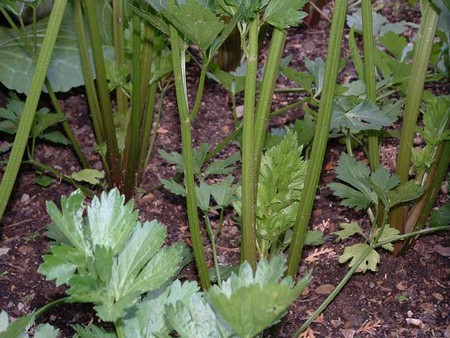Celery was cultivated in ancient Egypt and China. The cultivated form, Apium graveolens var. dulce, requires moist, well-drained, fertile soil, which is piled up around stems to blanch them. If grown only for its seeds, celery tolerates poor soil. Celery growing wild or in poor soil has a darker stem and is more bitter.
Celery is a culinary favourite, stuffed as an hors d’ocuvre, eaten raw in salads, and cooked in soups and stews. The seeds are a popular seasoning, used in salads and salad dressings or to give the flavour of celery to some hot dishes.
The seeds are the part of the celery plant that has been used medicinally. Though no medical uses have been proven, infusions of the seeds and leaves have been used to treat indigestion and loss of appetite, and for coughs. Infusions or commercial capsules have also been taken to combat gout and rheumatoid arthritis, in the unproven belief that they are mildly diuretic and thus Hush harmful compounds out of the body. The U.S. Food and Drug Administration has approved the plant and its seeds as safe for food use.
Do not eat celery seeds intended for cultivation, as they may have been treated with fungicide. During pregnancy avoid using large quantities of seed or the essential oil. Do not use celery medicinally if you are suffering from any kidney infections. Celery, especially the seeds, can cause serious allergic reactions. One compound contained in celery, the furocoumarin bergaptene, can cause sun sensitivity. This compound is especially concentrated in celeriac, also called celery root, which is a variety of celery (A. graveolens var. rapaceum,) grown for its swollen root. The combination of eating a lot of celery root and lying under ultraviolet sunlamps can cause a sunburn-like skin reaction.
Categories
Advertisements
Recent Articles
 How to Understand Bed Sizes – A Small Guide
How to Understand Bed Sizes – A Small Guide How to Select Some Must Have Kitchen Accessories
How to Select Some Must Have Kitchen Accessories Best Way to Change a Car Tire
Best Way to Change a Car Tire Best Way to Write an Affirmation
Best Way to Write an Affirmation Best Way to Take Charge of Your Financial Life
Best Way to Take Charge of Your Financial Life Best Way to Survive a Party When You Don’t Know Anyone
Best Way to Survive a Party When You Don’t Know Anyone Best Way to Stop Self Sabotaging Yourself
Best Way to Stop Self Sabotaging Yourself Best Way to Start Journal Writing
Best Way to Start Journal Writing Best Way to Speak with a Powerful Voice
Best Way to Speak with a Powerful Voice Best Way to Simplify Your Life
Best Way to Simplify Your Life Best Way to Respond to a Put-Down
Best Way to Respond to a Put-Down Best Way to Reduce Acne Breakouts
Best Way to Reduce Acne Breakouts Best Way to Recover from Dining Disasters
Best Way to Recover from Dining Disasters Best Way to Quit Your Job Gracefully
Best Way to Quit Your Job Gracefully Best Way to Make Your Own Website
Best Way to Make Your Own Website



Leave a Reply